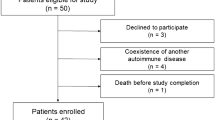Abstract
The objective of this study is to assess the serum IL-35 level and its association with clinical manifestations in patients with systemic sclerosis (SSc). IL-35 serum levels were measured by ELISA from 56 patients with SSc and 53 healthy controls. Association of IL-35 serum levels were sought with clinical parameters. Serum IL-35 levels were significantly higher in SSc patients (5.08 ± 0.76 pg/ml) than in healthy individuals (1.89 ± 0.69 pg/ml; p < 0.0001). Patients with lung fibrosis had higher IL-35 levels than those without fibrosis (7.75 ± 1.36 and 3.08 ± 0.70 pg/ml, respectively, p = 0.0022). IL-35 is elevated in the serum of patients with SSc and is associated with lung fibrosis. Our findings suggest that this cytokine can have a role in fibrotic diseases, but further studies are needed to address the role of IL-35 in the pathogenesis of SSc.

Similar content being viewed by others
References
Fenoglio D, Bernuzzi F, Battaglia F, Parodi A, Kalli F, Negrini S, De Palma R, Invernizzi P, Filaci G (2012) Th17 and regulatory T lymphocytes in primary biliary cirrhosis and systemic sclerosis as models of autoimmune fibrotic diseases. Autoimmun Rev 12(2):300–304
Slobodin G, Ahmad MS, Rosner I, Peri R, Rozenbaum M, Kessel A, Toubi E, Odeh M (2010) Regulatory T cells (CD4(+)CD25(bright)FoxP3(+)) expansion in systemic sclerosis correlates with disease activity and severity. Cell Immunol 261(2):77–80
Collison LW, Workman CJ, Kuo TT, Boyd K, Wang Y, Vignali KM, Cross R, Sehy D, Blumberg RS, Vignali DA (2007) The inhibitory cytokine IL-35 contributes to regulatory T-cell function. Nature 450(7169):566–569
Ning-Wei Z (2010) Interleukin (IL)-35 is raising our expectations. Rev Med Chil 138(6):758–766
Bardel E, Larousserie F, Charlot-Rabiega P, Coulomb-L'Hermine A, Devergne O (2008) Human CD4+ CD25+ Foxp3+ regulatory T cells do not constitutively express IL-35. J Immunol 181(10):6898–6905
Li X, Mai J, Virtue A, Yin Y, Gong R, Sha X, Gutchigian S, Frisch A, Hodge I, Jiang X et al (2012) IL-35 is a novel responsive anti-inflammatory cytokine—a new system of categorizing anti-inflammatory cytokines. PLoS One, 7(3):e33628
Banchereau J, Pascual V, O'Garra A (2012) From IL-2 to IL-37: the expanding spectrum of anti-inflammatory cytokines. Nat Immunol 13(10):925–931
Niedbala W, Wei XQ, Cai B, Hueber AJ, Leung BP, McInnes IB, Liew FY (2007) IL-35 is a novel cytokine with therapeutic effects against collagen-induced arthritis through the expansion of regulatory T cells and suppression of Th17 cells. Eur J Immunol 37(11):3021–3029
Kochetkova I, Golden S, Holderness K, Callis G, Pascual DW (2010) IL-35 stimulation of CD39+ regulatory T cells confers protection against collagen II-induced arthritis via the production of IL-10. J Immunol 184(12):7144–7153
Wirtz S, Billmeier U, McHedlidze T, Blumberg RS, Neurath MF (2011) Interleukin-35 mediates mucosal immune responses that protect against T-cell-dependent colitis. Gastroenterology 141(5):1875–1886
Preliminary criteria for the classification of systemic sclerosis (scleroderma) (1980) Subcommittee for scleroderma criteria of the american rheumatism association diagnostic and therapeutic criteria committee. Arthritis Rheum 23(5):581–590
LeRoy EC, Medsger TA (2001) Criteria for the classification of early systemic sclerosis. J Rheumatol 28(7):1573–1576
Clements P, Lachenbruch P, Siebold J, White B, Weiner S, Martin R, Weinstein A, Weisman M, Mayes M, Collier D (1995) Inter and intraobserver variability of total skin thickness score (modified Rodnan TSS) in systemic sclerosis. J Rheumatol 22(7):1281–1285
Ouyang H, Shi YB, Liu ZC, Wang Z, Feng S, Kong SM, Lu Y (2014) Decreased interleukin 35 and CD4 + EBI3+ T cells in patients with active systemic lupus erythematosus. Am J Med Sci 348(2):156–161
Qiu F, Song L, Yang N, Li X (2013) Glucocorticoid downregulates expression of IL-12 family cytokines in systemic lupus erythematosus patients. Lupus 22(10):1011–1016
Senolt L, Filkova M, Hulejova H, Cerezo LA, Pecha O, Plestilova L, Jarosova K, Pavelka K, Vencovsky J, Mann HF (2011) Decrease of serum IL-35 predicts clinical improvement in patients with very early RA [abstract]. Arthritis Rheum, 63(Suppl 10)
Filkova M, Hulejova H, Polanska M, Cerezo LA, Vencovsky J, Pavelka K (2010) Pro-Inflammatory properties of IL-35 and its association with disease activity in patients with rheumatoid arthritis [abstract]. Arthritis Rheum, 62(Suppl 10)
Giovannetti A, Rosato E, Renzi C, Maselli A, Gambardella L, Giammarioli AM, Palange P, Paoletti P, Pisarri S, Salsano F et al (2010) Analyses of T cell phenotype and function reveal an altered T cell homeostasis in systemic sclerosis. Correlations with disease severity and phenotypes. Clin Immunol 137(1):122–133
Liu X, Gao N, Li M, Xu D, Hou Y, Wang Q, Zhang G, Sun Q, Zhang H, Zeng X (2013) Elevated levels of CD4(+)CD25(+)FoxP3(+) T cells in systemic sclerosis patients contribute to the secretion of IL-17 and immunosuppression dysfunction. PLoS One 8:e64531, United States
Jiang N, Li M, Zeng X (2014) Correlation of Th17 cells and CD4(+)CD25(+) regulatory T cells with clinical parameters in patients with systemic sclerosis. Chin Med J (Engl) 127(20):3557–3561
Ishida T, Kotani T, Takeuchi T, Makino S (2012)Pulmonary toxicity after initiation of azathioprine for treatment of interstitial pneumonia in a patient with rheumatoid arthritis. In: J Rheumatol. vol. 39. Canada, 1104-1105
Acknowledgments
We thank the Brazilian National Research Council, the Research Foundation of Pernambuco State, and the National Institute for Science and Technology in Pharmaceutical Innovation.
Disclosures
None.
Author information
Authors and Affiliations
Corresponding author
Rights and permissions
About this article
Cite this article
Dantas, A.T., Gonçalves, S.M.C., Pereira, M.C. et al. Increased IL-35 serum levels in systemic sclerosis and association with pulmonary interstitial involvement. Clin Rheumatol 34, 1621–1625 (2015). https://doi.org/10.1007/s10067-015-3006-y
Received:
Revised:
Accepted:
Published:
Issue Date:
DOI: https://doi.org/10.1007/s10067-015-3006-y



